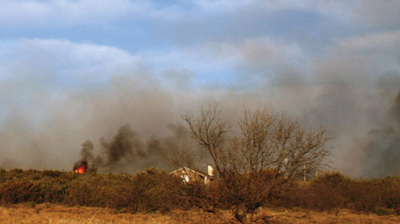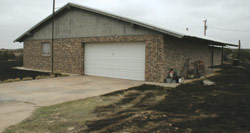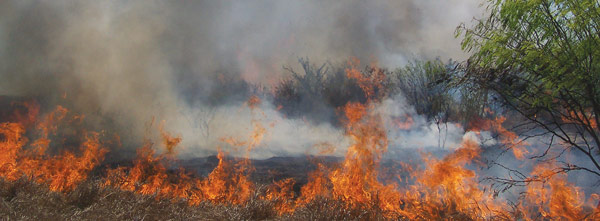
A wildfire threatens a house.
Extremely dry conditions, low humidity and high winds proved to be a devastating combination in March 2006, when a series of wildfires blazed across the Texas Panhandle.
Capital Farm Credit customer Ronnie Brown lives near Wheeler, Texas, and remembers the day well.
"I was having cattle delivered, and the driver told me there was a fire south of Pampa," Brown recalls. "I didn’t think much about it. About an hour later, my wife called to say the fire was heading toward us. Before I got home, I had to turn on my headlights, and it was the middle of the afternoon."
When he got to a rise, he looked out over his property. "All the electrical poles were on fire. I called my family and told them to jump in the car. We were leaving," he says.
Later, when Brown assessed the damage on his property, he realized that the fire had scorched 22,000 acres, killed more than 20 head of cattle and destroyed 72 miles of fence.
"It was bad, but it didn’t wipe us totally out. We were able to salvage many of our burned cattle," Brown says. "We were real lucky. The fire came within 50 yards of our home, but we had some ground plowed behind the house, and that turned it back."
The 2006 Panhandle fires later would be deemed the largest wildfires in state history. Approximately 1 million acres were burned, and 12 people and as many as 10,000 head of livestock were killed.
A Long Recovery
Brown was accustomed to dealing with small wildfires, but had never lived through anything of that magnitude. It took more than a year to repair the damaged fencing, this time using steel posts instead of wood.
The 22,000 acres are usable now but still not fully restored. The cottonwood trees that had stood for hundreds of years are gone. Continued drought has kept the land from rebounding as well as it could have.
"Once a fire starts, if you have something there that will burn, there’s not a whole lot you can do to stop it," Brown says. "And if you have cattle, you’re going to have grass. It’s a risk. But you can’t plan your business around ‘what if?’"
Preventive Measures Necessary in Rural Areas
Jan Fulkerson, Texas Forest Service urban wildland interface specialist, describes the perfect storm of conditions that occurred in 2006. "The vegetation was extremely drought-stressed and had cured out over the winter," Fulkerson explains. "On the day of that fire, we also had a dryline, with low humidity and winds gusting up to 65 miles per hour. That fire was jumping interstate highways, because of the wind."

A house is spared from fire.
Similar conditions triggered the wildfires in north Texas and Oklahoma in 2009. Having witnessed such damaging fires, Fulkerson is committed to helping people minimize their risk. "My main focus is to prevent loss of life and loss of structures. There are things people in rural areas can do that can help protect their homes in the event of a wildfire."
Just as Ronnie Brown proved the effectiveness of having plowed ground around his home, Fulkerson says there are strategies that can help. "I’ve seen fire go right past homes. You’re not going to stop the fire, but if you take the right steps, you can keep the flames low and less intense, and they might not get hot enough to ignite your home. That’s the goal."
Opie Blackwell, firewise coordinator with the Mississippi Forestry Commission, agrees. "Rural homeowners are not defenseless. You can take proactive steps to prepare your home and property to reduce the amount of nearby fuel and thereby lessen a wildfire’s intensity."
He describes rural areas as a wildland-urban interface where people and wildland fuels meet. "We see wildfires on TV in other states, and most of us don’t give it another thought, because we see it as ‘their problem’ and believe it won’t happen where we live," he says.
However, because rural areas are in the heart of the wildland-urban interface, wildfire is a real threat. Following are some steps homeowners should consider.
Maintain a defensible space around your home.
Remove or reduce flammable material in an area that extends at least 30 feet from your house in all directions. Keep this zone well-irrigated and mowed regularly. Keep grass short for a distance of 30 to 50 feet around structures. Prune shrubs and cut back tree branches, especially within 15 feet of your chimney, power lines or other structures. Relocate combustible materials, including propane tanks and firewood.
Remove leaves and debris from the roof, gutters or downspouts that could easily be ignited by hot embers. Have fire tools handy, such as connected garden hoses, a ladder long enough to reach your roof, a shovel, a rake, and a bucket or two for water.
If the house is on a slope, increase the defensible zone to at least 75 feet. Fire travels 16 times faster up a slope than on level ground.
"Reducing the fuel 100 to 200 feet from the home increases the safety margin as well," Blackwell says. "Well-managed defensible space gives firefighters a chance."
Landscape with less flammable plants.
Choose plants and trees with high moisture content in the leaves and low oil or resin content. Plants with strong smells, such as rosemary, have more oil and are more volatile. Consider whether a plant is tight-branched or airy. The denser a plant, the more heat it will generate if it burns. Also, take out ladder fuels, which are subsequent plantings of grass and groundcovers, shrubs and then trees that carry fire from vegetation to a structure.
Incorporate rock into the landscaping
Fulkerson recommends an 18-inch to 36-inch border of gravel around the home and wooden attachments, including fences.
She also encourages people to break up their landscaping by using rock. "I call it hardscaping. If you can incorporate stone paths, gravel, big rocks, stone walls, raised planters, anything like that, then you will break up the contiguous planting and help to slow fire."
Use construction materials that are fire-resistant or noncombustible.
The roof is the most vulnerable part of any structure. Consider using materials such as Class-A asphalt shingles, slate or clay tile, metal or cement and concrete products. Additionally, the inclusion of a fire-resistant sub-roof adds protection.
Wall materials that resist heat and flames include cement, plaster, stucco and concrete masonry. These choices are better than vinyl, which can soften and melt.
Make it easier for fire response units
All road signs and house address numbers should be reflective, made of noncombustible materials and visible from the road. Include a driveway that is at least 12 feet wide with a vertical clearance of 15 feet to provide access to emergency vehicles.
Develop a disaster plan
Take a few minutes to discuss an emergency plan with your family. Remember to consider your pets and to plan two escape routes out of your home and out of your neighborhood.
– Staff
For more information, visit www.firewise.org. Firewise is a national program that educates homeowners on fire-resistant home design, construction, landscape and maintenance techniques.

Fire Prevention Strategies for Landowners
Fire prevention experts offer these tips to help landowners prepare for wildfire.
Establish Firebreaks — Firebreaks are strips of fire-resistant vegetation, bare ground or a combination that serve to slow the fire. Install them between buildings and fields, and along fences and roadways, by plowing or blading wide strips of land.
Fight fire with fire — Prescribed burns can decrease wildfire danger by reducing fuel loads. It is important, however, that a prescribed burn be carried out under precise weather conditions by people trained in the use of fire as a management tool. Many government agencies, including the NRCS, the U.S. Fish and Wildlife Service and state Extension services, can be a great help in developing a burn plan.
Watch your actions — According to the U.S. Forest Service, 76 percent of southern wildfires are caused by humans. Many wildfires have been accidently set by well-meaning landowners performing everyday activities, such as burning debris, welding or simply driving across a dry field. Be watchful of catalytic converters. Equip all machinery with proper spark arrestors. When welding, be sure the work area is free of grass and debris. Have a spotter and water source handy. Before outdoor burning, check with your local forestry commission about burn bans and contact district offices for permits.